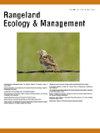季节气候对山艾草-草原植物群落生产的影响
IF 2.4
3区 环境科学与生态学
Q2 ECOLOGY
引用次数: 0
摘要
准确的植物生产模型和预测是整个大盆地利益相关者做出季节性牲畜管理决策的关键需求,该地区受到野火、入侵物种和季节性气候年变率的影响越来越大。目前,气候预测中心(CPC)和北美多模式集合(NMME)计划提供了高质量和时空完整的网格化气候预报,但这些预报仅限于月降水和温度参数。建立植物产量预测的必要第一步是量化植物产量与这些基本气候输入之间的时空关系。摘要本研究旨在量化10年来季节降水和温度对大盆地山艾蒿草原5种生态状态下的二生草(Poa secunda)和多年生草、多年生草本、一年生草本、一年生草本功能群的影响。总体而言,在大多数生态状态和植物功能群中,前一年较凉爽湿润的春季条件和较凉爽的夏季温度是植物生产的最强驱动因素。然而,这些差异取决于给定的生态状态和植物功能类群。这些结果表明,利用CPC和NMME程序提供的气候指标对该生态系统生长季节的植物产量进行预测是可行的。本文章由计算机程序翻译,如有差异,请以英文原文为准。
Seasonal Climate Effects in Sagebrush-Steppe Plant Community Production
Accurate models and forecasts of plant production are a critical need of stakeholders across the Great Basin for making decisions about seasonal livestock management in a region that is increasingly impacted by wildfires, invasive species and yearly variability in seasonal climate. High quality and spatiotemporally complete gridded climate forecasts are now available through the Climate Prediction Center (CPC) and North American Multi-Model Ensemble (NMME) programs, but these forecasts are limited to monthly precipitation and temperature parameters. A necessary first step to creating plant production forecasts is to quantify the spatiotemporal relationships between plant production and these basic climate inputs. The objective of this study was to quantify how seasonal precipitation and temperature affected plant production among the plant species Poa secunda and the functional groups of perennial grasses, perennial forbs, annual grasses, and annual forbs within five ecological states in the Great Basin Sagebrush Steppe over a 10-year period. In general, cooler and wetter spring conditions and cooler summer temperatures in the preceding year were the strongest drivers of plant production across most ecological states and within plant functional groups. These differences were, however, dependent on the given ecological state and plant functional group. These findings indicate that plant production forecasting is feasible for this ecosystem during the growing season when using the climate metrics provided by the CPC and NMME program.
求助全文
通过发布文献求助,成功后即可免费获取论文全文。
去求助
来源期刊

Rangeland Ecology & Management
农林科学-环境科学
CiteScore
4.60
自引率
13.00%
发文量
87
审稿时长
12-24 weeks
期刊介绍:
Rangeland Ecology & Management publishes all topics-including ecology, management, socioeconomic and policy-pertaining to global rangelands. The journal''s mission is to inform academics, ecosystem managers and policy makers of science-based information to promote sound rangeland stewardship. Author submissions are published in five manuscript categories: original research papers, high-profile forum topics, concept syntheses, as well as research and technical notes.
Rangelands represent approximately 50% of the Earth''s land area and provision multiple ecosystem services for large human populations. This expansive and diverse land area functions as coupled human-ecological systems. Knowledge of both social and biophysical system components and their interactions represent the foundation for informed rangeland stewardship. Rangeland Ecology & Management uniquely integrates information from multiple system components to address current and pending challenges confronting global rangelands.
 求助内容:
求助内容: 应助结果提醒方式:
应助结果提醒方式:


